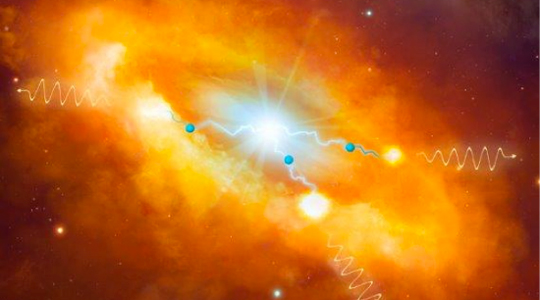 A combined analysis of data from Fermi, NASA's space telescope for the study of gamma rays, in which Italy participates with INFN, the National Institute of Astrophysics (INAF) and the Italian Space Agency (ASI), and from the HESS terrestrial telescope in Namibia, suggests that the centre of our Milky Way contains a "trap" capable of concentrating some of the fastest particles in the galaxy: highest energy cosmic rays. While Fermi detects gamma rays when they enter its LAT (Large Area Telescope) detector, on the ground HESS detects the emission when the atmosphere absorbs the gamma rays, triggering a cascade of particles that in turn produce a blue light flash, called Cherenkov light. Last March, scientists at the HESS collaboration found evidence of a diffuse flash of gamma rays at the centre of the galaxy, reaching almost 50 trillion electron volts (TeV). These are about 50 times higher than the energies of the gamma rays observed by Fermi's LAT.
The analysis published in Physical Review Letters combines the low energy LAT data with the high energy HESS data: the result is a continuous gamma ray spectrum that describes the emission from the centre of the galaxy in a range ranging from a few GeV up to 50 TeV. The study also confirms previous LAT results, indicating that cosmic rays along the plane of the Milky Way are more energetic as they approach the centre of the galaxy. How and where exactly the cosmic rays reach these energies continues to remain a mystery.
This behaviour is interpreted as a change in the way cosmic rays move through our galaxy, with the more energy-charged particles constrained for long periods in the central region.
A combined analysis of data from Fermi, NASA's space telescope for the study of gamma rays, in which Italy participates with INFN, the National Institute of Astrophysics (INAF) and the Italian Space Agency (ASI), and from the HESS terrestrial telescope in Namibia, suggests that the centre of our Milky Way contains a "trap" capable of concentrating some of the fastest particles in the galaxy: highest energy cosmic rays. While Fermi detects gamma rays when they enter its LAT (Large Area Telescope) detector, on the ground HESS detects the emission when the atmosphere absorbs the gamma rays, triggering a cascade of particles that in turn produce a blue light flash, called Cherenkov light. Last March, scientists at the HESS collaboration found evidence of a diffuse flash of gamma rays at the centre of the galaxy, reaching almost 50 trillion electron volts (TeV). These are about 50 times higher than the energies of the gamma rays observed by Fermi's LAT.
The analysis published in Physical Review Letters combines the low energy LAT data with the high energy HESS data: the result is a continuous gamma ray spectrum that describes the emission from the centre of the galaxy in a range ranging from a few GeV up to 50 TeV. The study also confirms previous LAT results, indicating that cosmic rays along the plane of the Milky Way are more energetic as they approach the centre of the galaxy. How and where exactly the cosmic rays reach these energies continues to remain a mystery.
This behaviour is interpreted as a change in the way cosmic rays move through our galaxy, with the more energy-charged particles constrained for long periods in the central region.






